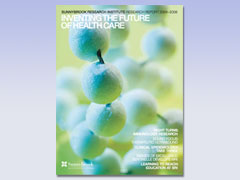Clinical Epidemiology: Take Three - Rabeneck
The research in which Linda Rabeneck engages is what she likes to call "policy relevant," a label that suggests it has very real-life consequences. "We set the bar very high here, and we're trying to do research that's not just 'Oh gosh, that's intriguing.'" It is also, she says, identifiable for her level of involvement in its nuts and bolts. "I've always taken a dim view of folks who are making broad policy statements but not contributing to the area," Rabeneck, who is also a senior scientist. "I think to fully understand the field you have to be working in it and contributing to it."
Rabeneck has engaged in both recently, in the service of more accurately defining the limitations and applications of colorectal cancer research. A colonoscopy is the final common pathway for any abnormalities revealed through a colon cancer screening test. But while it may be the best tool available for detecting polyps and cancer in the colon, it's still some distance from perfect. It was Rabeneck's dismay over stories from colon cancer patients about colonoscopies that missed their diagnoses that spurred her to research investigating its accuracy.
Focusing on 2,654 patients newly diagnosed with cancer on the right side of their colon (the most technically difficult to reach) who had surgery for their cancer between 1997 and 2001 and a colonoscopy in the preceding three years, Rabeneck honed in on the last colonoscopy before the diagnosis, and considered the interval. If the colonoscopy was within six months of the diagnosis, she determined, it found the cancer. But for those diagnosed between six months and three years after their test, the "miss rate" was alarming. Specifically, it was 4%: the cancer in 105 of 2,654 patients had been overlooked by the very test undertaken to find it.
The results of this retrospective cohort study were published in Gastroenterology in 2004.
The translation of this grim fact to the reality of a patient's life is easy, says Rabeneck. It means now, in addition to explaining the various physical risks of the procedure (e.g., bleeding, a punctured bowel), a doctor must include noting the possibility that, "If you have cancer, there's a small chance I might miss it."
Rabeneck, about whom SRI senior scientist Thérèse Stukel admires, "her intellectual curiousity, her absolute rigour in doing research and her openness to comments from [others]," has also investigated the issue of setting an upper-age cutoff for colonoscopy screenings. Currently, international recommendations say these tests should begin at age 50, but nobody's ever put a ceiling on them. They should, believes Rabeneck, who has a strong family history of the disease. A person's likelihood of developing colon cancer rises beyond the age of 50, but his life expectancy goes down. And, again, colonoscopies are not without risk.
Her study, published in The Journal of the American Medical Association in 2006, examines the tradeoff, and concludes that a colonoscopy screening lends an 80-year-old only 15% of the expected gain in life expectancy that it does younger patients. This finding, says Rabeneck, "should be factored into decision-making about whether elderly patients should be screened."
Rabeneck's miss rates research was funded by the Cancer Quality Council of Ontario, where she is a senior investigator, through salary support; the study on colonoscopy age caps was funded by her colleagues in the gastrointestinal section of the Virginia Mason Medical Center in Seattle, WA.
- Read the rest of Clinical Epidemiology: Take Three



